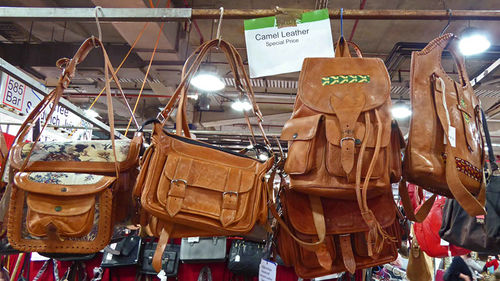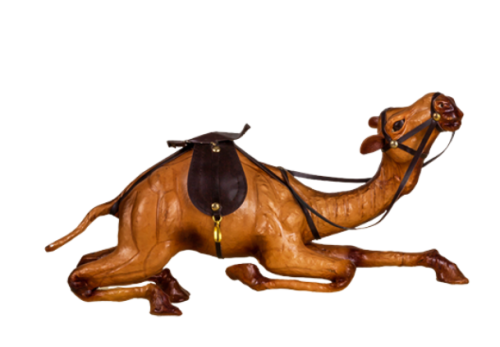The Harmonized System (HS) code for camel leather is 64032019 for camel leather imports and 64061020 for camel finished leather exports
Understanding Camel Leather: A Key Export from India
Camel leather is a distinctive and durable material with unique properties that make it a sought-after resource in both domestic and international markets. India, with its rich tradition of craftsmanship and access to camel herds, plays a significant role in the production and export of camel leather. This article delves into various aspects of camel leather, including its types, manufacturing hubs in India, uses, export destinations, market size, and the policies governing its trade.
What is Camel Leather?
Camel leather is derived from the hide of camels and is known for its toughness, elasticity, and resistance to wear and tear. It is characterized by a unique texture, making it an ideal material for premium products. The leather is typically more durable than other hides due to the camel's natural adaptation to harsh desert climates.
Types of Camel Leather
- Full-Grain Camel LeatherThis is the highest quality and most durable type, retaining the natural grain of the camel's hide. It is often used for high-end products like wallets, belts, and footwear.
- Top-Grain Camel LeatherSlightly less expensive, this type undergoes some processing to remove imperfections, making it smoother and easier to dye.
- Suede Camel LeatherThis type is made from the underside of the hide, offering a softer and more flexible texture ideal for fashion accessories and upholstery.
Camel Leather Manufacturing Units in India
India is home to several camel leather manufacturing units, primarily concentrated in regions with significant camel populations. The leading states include:
- RajasthanRajasthan, with its vast camel herds and skilled artisans, is a hub for camel leather production. Cities like Jaipur and Bikaner are known for their leather goods.
- GujaratGujarat also has camel-rearing communities and manufacturing units producing leather goods for domestic and international markets.
- HaryanaHaryana’s leather industry benefits from its proximity to camel-rearing regions, contributing to camel leather processing.
- Uttar PradeshThe state, a leader in leather production, also includes camel leather in its portfolio, particularly in areas like Kanpur and Agra.
Uses of Camel Leather
Camel leather is versatile and is used across various industries to create a wide range of products, including:
- Fashion Accessories: Belts, wallets, handbags, and shoes.
- Furniture: Upholstery for chairs and sofas.
- Automobile Interiors: High-end car seats and steering wheel covers.
- Sporting Goods: Gloves and protective gear.
- Luxury Items: Watch straps, book covers, and custom-made goods.
Camel Leather Exports from India
India is a significant exporter of camel leather, catering to the global demand for high-quality, durable, and eco-friendly materials.
Countries Importing Camel Leather from India
As of recent trade data, Indian camel leather is exported to over 50 countries, including:
- United States
- United Kingdom
- Germany
- France
- Italy
- China
- Japan
- United Arab Emirates
These countries value Indian camel leather for its superior quality and craftsmanship.
Market Size of Camel Leather
Local Market
In India, camel leather products hold a niche yet growing market. Traditional and modern designs appeal to domestic consumers, particularly in urban areas.
International Market
The global leather market, including camel leather, is expected to grow steadily due to increasing demand for eco-friendly and sustainable materials. Camel leather from India contributes significantly to this market, with exports valued in the millions annually.
Government of India Policies on Camel Leather
The Government of India has implemented policies and initiatives to support the leather industry, including camel leather production:
- Leather Sector Skill Council (LSSC)Focused on enhancing skills in leather processing and product manufacturing.
- Make in India CampaignEncourages local production and international investment in the leather industry.
- Export IncentivesSchemes like Merchandise Exports from India Scheme (MEIS) offer benefits to exporters of leather goods.
- Animal Welfare RegulationsStricter laws govern camel treatment and ensure ethical sourcing of hides.
- Leather Development ProgramsFinancial assistance for modernizing leather processing units and improving product quality.
Challenges in Camel Leather Industry
Despite its potential, the camel leather industry faces challenges:
- Animal Welfare ConcernsEthical issues regarding camel slaughter and hide sourcing.
- Environmental RegulationsCompliance with global standards for pollution control in leather processing.
- CompetitionFrom other types of leather and synthetic alternatives.
Conclusion
Camel leather from India is an invaluable resource, blending tradition, craftsmanship, and modern manufacturing techniques. With a strong presence in domestic and global markets, its production and export contribute significantly to India’s economy. As the world shifts toward sustainable and ethical products, camel leather, supported by government policies and initiatives, is poised for continued growth and innovation.







